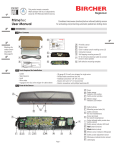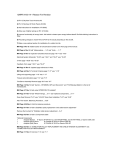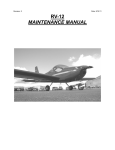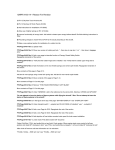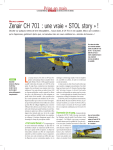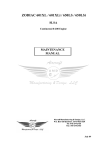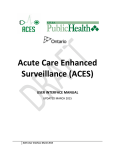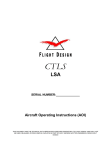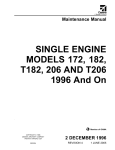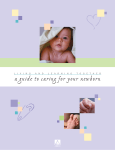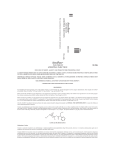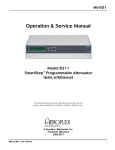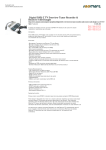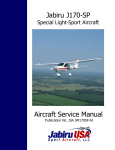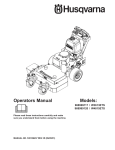Download SERVICE MANUAL - Long Island Flying
Transcript
CH2000 TRAINER with LYCOMING 0-235-N2C SERVICE MANUAL ZENAIR Ltd. Huronia Airport Midland, Ontario Canada L4R 4K8 (705) 526-2871 November 2002 ZENAIR CH2000 SERVICE MANUAL _______________________________________________________________________ TABLE OF CONTENTS SECTION I SECTION II SECTION III SECTION IIIA SECTION IV SECTION V INTRODUCTION HANDLING AND SERVICING INSPECTION AIRWORTHINESS LIMITATIONS STRUCTURE LANDING GEAR AND BRAKES SECTION VI SECTION VII SECTION VIII SECTION IX SECTION X SECTION XI SECTION XII POWERPLANT SURFACE CONTROLS FUEL SYSTEM INSTRUMENTS ELECTRIC SYSTEM HEATER /VENTILATION CABIN DOORS LIST OF EFFECTIVE PAGES Section Page Date Section Page Date Section Page Date 0 0 1 1 1 2 2 2 2 2 2 2 2 2 3 3 3 3 3 3 3 3 3 3 3 4 4 4 4 4 0.1 0.2 1.1 1.2 1.3 2.1 2.2 2.3 2.4 2.5 2.6 2.7 2.8 2.9 3A 3.1 3.2 3.3 3.4 3.5 3.6 3.7 3.8 3.9 3.10 4.1 4.2 4.3 4.4 4.5 Nov-02 Nov-02 Nov-02 Apr 96 Apr 95 Apr 95 Oct-00 Nov-02 Nov-02 Oct-00 Feb-00 Apr 96 Feb-00 Feb-00 1 Sep 95 Nov-02 Oct-00 Nov-02 Nov-02 Nov-02 Nov-02 Nov-02 Nov-02 Nov-02 Nov-02 Nov-02 Apr 95 Nov-02 Oct-00 Oct-00 5 5 5 5 5 5 6 6 6 6 6 7 7 7 7 7 7 7 8 8 8 8 8 9 9 9 9 9 9 9 5.1 5.2 5.3 5.4 5.5 5.6 6.1 6.2 6.3 6.4 6.5 7.1 7.2 7.3 7.4 7.5 7.6 7.7 8.1 8.2 8.3 8.4 8.5 9.1 9.2 9.3 9.4 9.5 9.6 9.7 Nov-02 Nov-02 Nov-02 Apr 95 Nov-02 Nov-02 Feb-00 Nov-02 Apr 96 Feb-00 Feb-00 Feb-00 Nov-02 Nov-02 Feb-00 Feb-00 Oct-00 Nov-02 Feb-00 Apr 95 Nov-02 Apr 96 Apr 96 Apr 95 Oct-00 Jul 95 Apr 96 Apr 95 Nov-02 Apr 95 9 9 9 9 9 9 10 10 10 10 10 10 10 10 11 11 12 9.8 9.9 9.10 9.11 9.12 9.13 10.1 10.2 10.3 10.4 10.5 10.6 10.7 10.8 11.1 11.2 12-1 Apr 95 Apr 95 Apr 95 Apr 95 Apr 95 Apr 95 Apr 95 Oct-00 Oct-00 Apr 96 Sep 95 Apr 95 Apr 95 Oct-00 Nov-02 Nov-02 Nov-02 Nov-02 0.1 ZENAIR CH2000 SERVICE MANUAL _______________________________________________________________________ SERVICE MANUAL UPDATE LOG REV. NO. DATE ISSUED DATE INCORPORATED 1 to 8 Nov. 2002 AT ISSUE INSERTED BY Note: 0.1 and 0.2 with Update sheet(s) are replaced for each new update. 0.2 Nov-02 ZENAIR CH2000 SERVICE MANUAL ________________________________________________________________________ SECTION 1 INTRODUCTION GENERAL This manual contains service and maintenance instructions for the Zenair CH2000, designed and manufactured as a versatile two-seat aircraft in the personal and training aviation field. SCOPE OF MANUAL Sections II and III comprise the service part of this manual, whereas Sections IV through XI comprise the maintenance instructions. The service instructions include ground handling, servicing, and inspection periods. The maintenance instructions for each system include troubleshooting, removal and installation of components, and corrective maintenance and testing; each major system of the aircraft is covered in a separate section. Only qualified personnel should perform the operations described in this manual. In the text, reference is made to the following publications: - General: Owner’s Manual or Aircraft Flight Manual CH2000 - ZENAIR Parts Catalogue CH2000 - ZENAIR - Engine: Operator’s Manual and overhaul manual Series O-235 engines - Textron Lycoming - Propeller: Prop. Logbook (instructions for use and care) - Sensenich Prop. Co. AC-43.13.1B Aircraft Inspection, Repair and Alteration is a useful handbook published by the FAA. “Aircraft Powerplants”, published by McGraw-Hill (ISBN #0-07-035569-X) is the standard reference for the mechanic working on the engine. The description of the aircraft included in this section is limited to general information; however, the figure gives specific external dimensions. Nov-02 1.1 ZENAIR CH2000 SERVICE MANUAL ________________________________________________________________________ DESCRIPTION - Fig. 1 The Zenair CH2000 is a single engine, two-seat, low-wing monoplane of all-metal construction. WING: The wing is of all-metal stressed-skin, full cantilever, low-wing design, consisting of two wing panels bolted to a spar box assembly in the fuselage. The ailerons are cable and push rod controlled. The wing trailing edge split flaps are electrically operated. EMPENNAGE: The empennage consists of the rudder, stabilator, and stabilator trim tabs. The stabilator is dynamically balanced. FUSELAGE: The fuselage consists of three basic sections: the engine section, the cabin section, and the sheet-metal tail cone. LANDING GEAR: The tricycle landing gear is of the fixed type, consisting of a nose wheel and two main wheels. HYDRAULIC SYSTEMS: The dual brake system is operated by master cylinders. ENGINE: The aircraft is powered by one horizontally opposed Lycoming Model 0-235N2C four-cylinder air-cooled engine. The engine employs a wet sump oil system with oil temperature and pressure indicators. PROPELLER: The propeller used is a Sensenich fixed pitch, all metal, aluminum alloy, Model 72-CK series. FUEL SYSTEM: The fuel system on the Zenair CH2000 consists of one rear aluminum tank or tanks in the wings, one engine-driven pump, and one electrical auxiliary pump. FLIGHT CONTROLS: The flight controls are conventional equipment, consisting of a control wheel which operates the ailerons and stabilator, and pedals which operate the rudder. Duplicate controls are provided for the co-pilot. RADIO: Provisions for radio installations consist of microphone and headset jacks and mounting brackets, necessary wiring, and panel space for extra radios. CABIN HEATER, DEFROSTER, AND FRESH AIR SYSTEM: Heated air for the cabin and defroster is obtained directly from the exhaust system muffler shroud. Fresh air is supplied to the cabin through two individual and orientable air inlet vents in the right and left door window. INSTRUMENTS: Provisions for optional instruments are provided, including full IFR equipment. 1.2 3 Apr 96 ZENAIR CH2000 SERVICE MANUAL ________________________________________________________________________ CH 2000 GENERAL DIMENSIONS - Fig. 1 3 Apr 95 1.3 ZENAIR CH2000 SERVICE MANUAL ________________________________________________________________________ SECTION II HANDLING AND SERVICING GENERAL This section provides ground handling and servicing instructions. Recommended ground handling procedures, and recommended methods of servicing are provided in following paragraphs. If trouble or damage to the aircraft is discovered during ground handling or servicing, refer to the appropriate section for the system concerned. Lubrication is treated as a separate function. ACCESS PROVISIONS - Fig. 2 The figure shows the location and identity of the access doors and panels that provide access for purposes of service and maintenance. GROUND HANDLING GENERAL. The aircraft must not be pushed, pulled, or lifted by any other means than those described. Procedures are given for the proper execution of all necessary handling operations and, if the instructions are followed, damage to the aircraft or its equipment will be prevented. Caution: Use the utmost care at all times during ground handling operations. STEP, HANDHOLD, AND WALKWAYS A fixed step is located on each side, below and aft of the inboard end of the wing trailing edge and fixed handholds are located on the sides of the fuselage, above the aft upper corner of the rear window. The walkway is made up of a non-skid compound applied to the wing surface. Caution: Walk on the walkways only, to avoid damage to the wings. 3 Apr 95 2.1 ZENAIR CH2000 SERVICE MANUAL ________________________________________________________________________ CH2000 ACCESS PANELS - Fig. 2 2.2 Oct-00 ZENAIR CH 2000 SERVICE MANUAL ________________________________________________________________________ HOISTING - Fig. 3 Nose Gear Hoisting - Remove the cowl and lift the aircraft with a hoist attached to the metal loop on top of the engine. Main Gear Hoisting - Lift the aircraft one side at a time and insert a padded sawhorse or equivalent under wing at main wing spar and rib rivet line. LEVELING - Fig. 4 The aircraft may be leveled while the wheels are on the ground or during the weighing procedure while the wheels are on scales. Leveling the aircraft for purposes of reweighing or rigging is accomplished as follows: Position the level on the door sill (upper fuselage longeron) To put the airplane in a longitudinally level position, either on scales or on the floor, deflate the nose wheel tire until the proper position is reached (or add shims under the two main wheels ). To level the airplane laterally, place a level across the cabin on the right and left longerons, shim one main wheel as required. (repeat longitudinal leveling). WEIGHING PROCEDURE - See Owner's Manual or Aircraft Flight Manual Chapter 6 TIEING DOWN Secure tie-down ropes to the wing tie-down rings and the tail skid at approximately 45° angles to the ground. Leave sufficient slack to avoid damage to the aircraft when the ropes contract due to moisture. TOWING Move the aircraft using the nose wheel optional tow bar hooked into the nose gear strut rings. Caution: Remove the tow bar when not in use as the propeller may hit it when engine is started. Nov-02 2.3 ZENAIR CH2000 SERVICE MANUAL ________________________________________________________________________ LOCKING AIRCRAFT The cabin doors are provided with key locks on the outside. MAIN GEAR / WHEEL HOISTING NOSE GEAR / WHEEL HOISTING 2.4 Nov 02 ZENAIR CH2000 SERVICE MANUAL ________________________________________________________________________ AIRCRAFT LEVELING - Fig. 4 – Oct-00 2.5 ZENAIR CH2000 SERVICE MANUAL ________________________________________________________________________ SERVICING FUEL SYSTEM FILLING FUEL TANKS Observe all required precautions for handling gasoline. Fill the fuel tanks with the fuel specified in the engine Operator’s Manual. DRAINING FUEL VALVE AND STRAINER - Fig. 5 The Gascolator is located under the fuselage near the left wing leading edge. It has a Curtis type easy drain valve and can be opened to clean the fuel filter. Note: fuel shut-off valve should be in the "OFF" position when opening the Gascolator. The Gascolator should be drained regularly to check for water. REAR FUEL TANK SYSTEM The fuel tank and sump are drained through the Curtis valve beside the Gascolator. The fuel strainer at the tank outlet is accessed for removal and cleaning through the large access door under the fuselage. (see page 7-9 of Owner’s Manual or AFM) WING TANKS OPTION The fuel tanks and sumps are drained through the Curtis valves under the wings just rear of the wheels. The fuel strainers at the tank outlets are accessed for removal and cleaning through the access panels beside the Curtis valves. (see next page F.5. Also page 9.6 of Owner’s Manual or AFM) 2.6 Feb-00 ZENAIR CH2000 SERVICE MANUAL ________________________________________________________________________ FUEL DRAINS - Fig. 5 - 3 Apr 96 2.7 ZENAIR CH2000 SERVICE MANUAL ________________________________________________________________________ LUBE OIL SYSTEM FILLING ENGINE SUMP Fill the engine sump with the specified lubricating oil. (See Owner’s Manual or Engine Manual.) Access door on right top cowl.(Fig. 2) DRAINING ENGINE SUMP Remove the cowl. Drain the engine sump by means of the oil drain plugs at the bottom of the oil sump. BRAKE SYSTEM - Fig. 11 on page 5.6 FILLING BRAKE CYLINDER RESERVOIRS The brake cylinder reservoirs are an integral part of the master cylinders on pilot side. They must be checked at every 50-hour inspection and replenished when necessary. No adjustment of brake clearance is necessary on the brakes. DRAINING BRAKE SYSTEM To drain the brake system, disconnect the hydraulic brake lines from the brake assembly of the main gear, and place the end of each line in a suitable container. Slowly pump the brakes until fluid ceases to flow. To clean the brake system, flush with denatured alcohol. LUBRICATION - Fig. 6 See the chart for lubrication instructions regarding the locations, time intervals, and types of lubricant used. Where light lubricating oil is specified, but unavailable, clean engine oil is a satisfactory substitute. Avoid excess application of lubricants. Excess lubricant on exterior surfaces of bearings tends to attract dirt and grit, and may lead to malfunction of the unit. 2.8 Feb-00 ZENAIR CH2000 SERVICE MANUAL ________________________________________________________________________ LUBRICATION CHART - Fig. 6 - Feb-00 2.9 ZENAIR CH2000 SERVICE MANUAL ________________________________________________________________________ SECTION IIIA AIRWORTHINESS LIMITATIONS GENERAL This Airworthiness Limitation section is accepted by the FAA. It can only be revised with prior FAA approval. LIFE LIMITED PARTS Following is the list of the parts which must be replaced at the frequencies indicated. - Fuel line hoses rear of firewall (5 years or 2400 hours, whichever occurs first.) - Brake lines (7 years) - Pitot static lines (7 years) - Electric Trim actuator (2400 hours) 3A. 1 Sep 95 ZENAIR CH2000 SERVICE MANUAL ________________________________________________________________________ SECTION III INSPECTION GENERAL This section provides instructions for conducting scheduled inspections, unscheduled inspections, replacement of time limited parts and corrosion control. Repair or replacement instructions for those components found to be unserviceable are in the sections covering the applicable aircraft system. Refer to Section II for lubrication and servicing instructions. Lubrication and servicing intervals should be adjusted to take into account the aircraft operating conditions. Refer to Section IIIA for Airworthiness Limitations. All of the inspections are general visual inspections unless otherwise specified. They are to be performed by trained and qualified personnel using appropriate tools and adequate lighting. Prior to commencing the scheduled inspections listed in Table 1: a. Thoroughly clean the aircraft and engine; b. Remove or open the necessary inspection and access panels, the engine cowlings, the spinner and the optional wheel fairings; and c. Review the aircraft records for outstanding Airworthiness Directives (AD’s) , Airworthiness Limitations (AWLs), Service Bulletins (SBs) or other maintenance requirements (pitot static system, ELT, fire extinguisher, etc.). Contact the manufacturer for latest AD, SB and Service Letters. Note: In addition to the tasks specified in Table 1, do the preflight inspections described in the Owner’s Manual. SCHEDULED INSPECTIONS Scheduled inspections include the items listed in Table 1 Inspection Form, the overhaul requirements for the engine and propeller, the calendar time inspections and the one-time inspections done following specified tasks. Do the following: Inspection Form Requirements Perform the tasks in Table 1 at the intervals shown. (Refer to Paragraph 6). Overhaul Requirements a. Overhaul the engine (Lycoming 0-235) every 2400 flight hours in accordance with Lycoming Direct Drive Engine Overhaul Manual P/N 602947. b. Overhaul the propeller (Sensenich Model 72-CK Series) every 2,000 flight hours in accordance with Sensenich overhaul instructions (Ref. SPRM #590). c. Overhaul the magnetos every 2,400 flight hours in accordance with the manufacturer’s instructions. (Ref. Unison Industries - Slick manual # L-1363 sect. 4). d. Overhaul the horizontal stabilator trim (electric) actuator every 2400 flight hrs. in accordance with the manufacturer’s overhaul instructions. Replacement of Time Limited Parts The following parts are subject to the effects of aging and environmental deterioration and must be replaced at the time indicated: Fuel Line Hoses ( rear of firewall) - 5 years or 2400 hours, whichever comes first. Brake Lines - 7 years Pitot Static Lines - 7 years Nov-02 3.1 ZENAIR CH2000 SERVICE MANUAL ________________________________________________________________________ Calendar Inspection Requirements a Perform a visual inspection of the pitot-static system connection Tygon splice at the wing root, for security and condition, every 12 months. b. Perform a visual inspection of the wing fuel tank compartments (if wing fuel tanks are installed) for corrosion, cracking, etc every 5 years. UNSCHEDULED INSPECTIONS Unscheduled inspections must be performed anytime that unusual operating conditions are encountered which may affect the integrity or airworthiness of the aircraft. Actions to be taken following the reporting of such events are as follows: a) Check ELT for inadvertent activation. Hard Landing b) Check main gear spring for deformation. c) Check nose gear and firewall for damage. Propeller Strike a) Check propeller for damages. b) Check prop flange re crankshaft damage. Lightning Strike a) Check ELT for inadvertent activation. b) Check skins for damages. c) Check control connections for damages. Bird Strike Check the area for damages Exceedence of Operational Limits Refer to applicable manuals INSPECTION AFTER SPECIFIED MAINTENANCE ACTIONS Inspections are to be performed one time only, following the performance of the following tasks: Installation of new alternator Check belt for condition and tension at 25 hours of belt drive belt. operation. (Ref. Lycoming Service Instruction #114) Installation of new, re-manufactured or overhauled engine. Perform a 50-hour engine inspection (Ref. Section 4 of Lycoming Operator’s Manual). CORROSION CONTROL To avoid the deterioration of the CH2000 aircraft due to the effects of corrosion, monitor the condition of protective coatings on exterior and interior surfaces. If damage to coatings is found, restore surfaces prior to the occurrence of damage caused by environmental effects. INSPECTION SCHEDULE The required inspection tasks and their intervals are listed in Table 1. The tasks are placed in seven groups: Propeller, Engine, Cabin, Landing Gear, Wing, Fuselage and Empennage. The first column of Table 1 states the task to be performed, the second column states the applicable references(s). The third column is divided into four sub-columns, each of which corresponds to an inspection interval. The last column may be used to verify that a task has been completed. Perform the stated tasks at the intervals shown when a plus (+) symbol is shown in an interval column. A minus (-) symbol indicates no maintenance action is required. Tasks may be performed sooner but not later than the stated intervals. If done sooner, tasks must next be performed at the stated interval (e.g. at 790 flight hours airframe time, a 100 hour task is performed 10 flight hours before it is due. It must next be performed 100 hours later, at 890 flight hours (or sooner). Operational checks are tasks that determine that an item is fulfilling its intended purpose. No verification of meeting tolerances is required. Functional checks are tasks which determine if one or more functions of an item are performing within specified limits. Quantitative checks must be performed. Useful Note: The 50 hour inspection has a tolerance of + 16% (ie between 42 and 58 hours) Oct-00 3.2 TABLE 1 – ZENAIR INSPECTION FORM Make / Model ZENAIR CH2000 Symbols: + Serial No. Registration No: Indicates perform task, Task Airframe Hours Type of Inspection (Circle One) 50 100 500 1000 Engine Hours - Indicates do not perform task Intervals (Flight Hours) Refer to 50 100 500 1000 Propeller Group 1. Check propeller bolts for torque and safeties. Sensenich Prop, Manual + + + + 2. Inspect blades and hub for cracks, corrosion, damage, etc. Sensenich Prop, Manual + + + + + + + + + + + + 3. Inspect spinner and backing plate. Engine Group Danger Ground magneto primary circuit before working on engine. Section X 1. Check for oil/fuel leaks. 2. Check for particles on oil suction screen and sump drain plug. Lycoming Operator’s Manual Section 7 + + + + 3. Drain oil and refill. Lycoming Operator’s Manual Section 7 + + + + 4. Perform cylinder compression test. - + + + 5. Clean the spark plugs. Adjust gap at .018” to .022”. - + + + Lycoming Operator’s Manual Section 5 Lycoming Operator’s Manual Section 4 - + + + - + + + Lycoming Operator’s Manual Section 4 Section VI + + + + + + + + + + + + - + + + + + + + + + + + 6. Check and set magneto timing at 200. 7. Check magneto breaker points and lubricate breaker point felt. 8. Clean oil suction and oil pressure screens 9. Inspect the wet type foam air filer. 10. Inspect the exhaust manifold for cracks (carb and cabin heat shroud removed). 150 HR INTERVALS (Ref. AD-CF-9003R2) Section XI 11. Inspect the heat shrouds for cracks, etc. 12. Inspect the motor mount fuselage and engine attachment points and braces. 13. Inspect the rubber engine vibration isolating mounts for cracks damage, etc. 3.3 Section VI Nov-02 Initials TABLE 1 – ZENAIR INSPECTION FORM Make / Model ZENAIR CH2000 Symbols: + Serial No. Registration No: Indicates perform task, Task Airframe Hours Type of Inspection (Circle One) 50 100 500 1000 Engine Hours - Indicates do not perform task Intervals (Flight Hours) Refer to 50 100 500 1000 14. Inspect engine for security of all attaching hardware (nuts, bolts, screw, etc.) - + + + - + + + 16. Inspect the ignition harnesses for general condition. + + + + 17. Inspect the carburetor air intake box for leaks. + + + + 15. Perform valve clearance check (0.010”) Lycoming Operator’s Manual Section 5 18. Drain carburetor and clean carburetor fuel strainer and strainer bowl. Section VI - + + + 19. Inspect engine cowlings for cracks, damage, loose rivets, etc. Section VI + + + + 20. Inspect the vacuum pump, lines and separator, Section VI - + + + 21. Change the Oil filter. Section VI + + + + + + + + - - + + - + + + 22. Inspect the oil radiator, oil lines and attaching brackets. 23. Clean and flush oil radiator. Section VI 24. Inspect engine, firewall and firewall seals for deterioration, cracking, etc. 25. Inspect cabin heat control box for cracks, condition, etc. Section XI + + + + 26. Inspect engine controls for defects, safeties, etc. Check control travels. Section VI - + + + 27. Check starter, alternator, fuel pump and vacuum pump for proper mounting, security and defects Section VI - + + + 28. Perform operational checks of all systems (fuel, oil, heating, etc.) Section VI - + + + 3.4 Nov-02 Initials TABLE 1 – ZENAIR INSPECTION FORM Make / Model ZENAIR CH2000 Symbols: + Serial No. Registration No: Indicates perform task, Task Airframe Hours Type of Inspection (Circle One) 50 100 500 1000 Engine Hours - Indicates do not perform task Intervals (Flight Hours) Refer to 50 100 500 1000 CABIN GROUP 1. Inspect the control wheels, linkages, column and torque tube assemblies for cracks, distortion, etc. Section VII - + + + 2. Check controls for ease of operation and correct travel. Section VII + + + + 3. Check operation cockpit lights and external lights. Section X + + + + 4. Check operation of all circuit breakers and switches. Section X + + + + 5. Check flight control cables for routing, fraying, corrosion and tension. Section VII - + + + Inspect flight control turnbuckles, pulleys and guides for wear, damage and safeties. Section VII - + + + 6. Check stabilator trim tab indicator for correct operation. Section VII + + + + 7. Inspect the flap motor, actuator, extension tube, actuator lever, interconnect tubes, control levers and control rods for cracks, distortion, security, etc. Section VII - + + + 7a Inspect flap indicator cable and indicator for security and correct operation. Section VII - + + + 8. Perform functional check of the flap system. Section VII + + + + 9. Inspect all windows for cracks, cleanliness, etc. + + + + 10. Check cabin finish for damage, deterioration, etc. - + + + 5a 11. Perform operational check of the fuel selector valve and safety lock. Section VIII + + + + 12. Inspect door fit and latching mechanisms. Section XII + + + + + + + + 13. Check upholstery for condition Nov-02 3.5 Initials TABLE 1 – ZENAIR INSPECTION FORM Make / Model ZENAIR CH2000 Symbols: + Serial No. Registration No: Indicates perform task, Task Airframe Hours Type of Inspection (Circle One) 50 100 500 1000 Engine Hours - Indicates do not perform task Intervals (Flight Hours) Refer to 50 100 500 1000 14. Inspect safety belts, attaching hardware, etc. for condition security. + + + + 15. Verify appropriate compass correction card is in aircraft. - + + + 16. Clean or replace filters in the gyro vacuum system (if installed). Section IX - + - + 17. Inspect radio installations and mounting hardware for security, condition. etc. Section IX - + + + 18. Inspect electrical wiring for condition, security, routing, damage, etc. - + - + 19. Check condition and security of all bonding wires. - + - + 20. Inspect antenna installations for condition, security, etc. - + + + 21. Inspect instruments for security, markings, condition and perform operational check. Section IX - + + + 22. Inspect fuel sender unit for security, leaks, etc. Section VIII - - - + 23. Inspect fuel primer (if installed) for security, condition, leaks, etc. + + - + 24. Check brake fluid level section V. + + + + 25. Inspect the aft side of the firewall from inside the cabin for cracks around any rivets. In case of repair, see Zenair Service bulletin No. 00-03, section B and C. - + + + - + + + Landing Gear Group 1. Inspect the main landing gear mainspring attachment bolts for proper torque, safeties, etc. 3.6 Section V Nov-02 Initials TABLE 1 – ZENAIR INSPECTION FORM Make / Model ZENAIR CH2000 Symbols: + Serial No. Registration No: Indicates perform task, Task Airframe Hours Type of Inspection (Circle One) 50 100 500 1000 Engine Hours - Indicates do not perform task Intervals (Flight Hours) Refer to 50 100 500 1000 2. Check security, condition, etc., of lateral stop and bolts and axle bolts. Section V - + + + 3. When removing wheels, inspect the brake assemblies, axles, pins and spacers for security, condition, leaks, etc. Section II, Section V + + + + 4. Check the brake pads and brake discs for excessive wear. Section V - + + + 5. Inspect the main wheels for cracks, corrosion, etc. - + + + 6. When removing wheels re-pack wheel bearings. Section V + + + + 7. Inspect the master and slave brake cylinders, brake lines, connections for damage, corrosion, leaks, etc. Service the master brake cylinders. Section V + + + + 7a Inspect the rubbers at the main landing gear attachments for condition and abrasion damage, and position Section V - + + + 8. When removing wheel, the airplane hoisted remove the nose wheel and inspect wheel for cracks, corrosion, etc. Section V + + + + 9. Inspect the nose gear lower front bearing plate, cam centering, steering connections strut, strut supports and stop plate for cracks, distortion, corrosion, etc. - + + + - + + + 10. Inspect the steering rods for security, distortion, etc. 11. Inspect the shock cord for damaged threads and weakness. Section V - + + + 12. Inspect the lower shock ring support for cracks, distortion, etc. Section V - + + + 13. Check tire pressure. (30 PSI) Section V + + + + 14. When removing wheel, inspect the nose wheel axle bolt, spacers and axle for wear, damage, corrosion, etc. Section V + + + + Nov-02 3-7 Initials TABLE 1 – ZENAIR INSPECTION FORM Make / Model ZENAIR CH2000 Symbols: + Serial No. Registration No: Indicates perform task, Task Airframe Hours Type of Inspection (Circle One) 50 100 500 1000 Engine Hours - Indicates do not perform task Intervals (Flight Hours) Refer to 50 100 500 1000 Wing Group 1. Check the torque and safeties of the front spar, main spar and rear spar wing to fuselage attachment bolts. Section IV 2. Inspect the external surfaces of the ailerons and flaps for cracks, deformation, etc. - + + + + + + + 3. Inspect the aileron and flap hinge pins for corrosion, wear, safeties and adequate lubrication. Section II - + + + 4. Inspect flap and aileron rods and rod attachment bolts for wear, damage safeties, etc. Section VII - + + + 5. Inspect aileron bellcranks, stops, cable ends and pulley assembly for cracks, damage, corrosion safeties, etc. Section VII - + + + + + + + + + + + + + + + + + + + + + + + - + + + 6. Inspect upper and lower wing skins and leading edges for cracks, loose fasteners, damage, etc. Section II 7. Lubricate the aileron and flap hinges, control rod ends, bellcranks, etc. 8. Inspect the dual landing/taxi lights for security, clean lenses, etc. Section II 9. Drain water from wing fuel tanks (if applicable) using sump drains. Check sump drains for leaks. Clean fuel strainers. 10. Check fuel tank filler caps (if installed) for security, condition, etc. 11. Perform an operational check of the stall warning system. 3-8 Nov-02 Initials TABLE 1 – ZENAIR INSPECTION FORM Make / Model ZENAIR CH2000 Symbols: + Serial No. Registration No: Indicates perform task, Task 12. Perform operational check of the pitot static heater (if installed). Airframe Hours Type of Inspection (Circle One) 50 100 500 1000 Engine Hours - Indicates do not perform task Intervals (Flight Hours) Refer to 50 100 500 1000 + + + Section IX - + + + + + + + - + + + - + + + 4. Inspect flight control turnbuckles, pulleys and guides for wear, damage and safeties. - + + + 5. Check flight control torque tube bearings for wear. - + + + 6. Inspect electrical wiring for condition, security, routing, damage, etc. - + + + 7. Inspect fuel lines for security, damage, and leaks. - + + + 8. Inspect the battery for condition, fluid level and clean terminals. Inspect the battery box. - + + + + + + + + + + + - + + + 13. Perform operational check of fuel quantity indicating system. Fuselage Group 1. Inspect the outer fuselage skin for cracks, corrosion, loose rivets, damage, etc. 2. Inspect fuselage bulkheads, stiffeners and internal structure for cracks, corrosion, damaged fasteners, etc. 3. Inspect flight control cables for routing, fraying, corrosion and tension. 9. Drain water from fuselage fuel tank using sump drain (if applicable). Check sump drain for leaks. Clean gascolator fuel filter. 10. Check fuel tank filler cap (if installed) for security, condition, etc. Section VII Section II Empennage Group 1. Inspect the vertical stabilizer, rudder, stabilator and trim tab skins for cracks, loose fasteners, damage, etc. Nov-02 3-9 Initials TABLE 1 – ZENAIR INSPECTION FORM Make / Model ZENAIR CH2000 Symbols: + Serial No. Registration No: Indicates perform task, Task Airframe Hours Type of Inspection (Circle One) 50 100 500 1000 Engine Hours - Indicates do not perform task Intervals (Flight Hours) Refer to 50 100 500 1000 2. Inspect stabilator trim actuator wheel for security, wear, damage, etc. - + + + 3. Perform operational check of stabilator trim system. Section VII - + + + 4. Inspect rudder, stabilator and trim tab hinges for wear and excessive play. Section VII - + + + 5. Lubricate the rudder and stabilaor trim tab hinges, the stabilator hinge points and the trim actuator. Section II + + + + 6. Inspect the stabilator balance weight, stops and grounding strap for security, condition, damage, etc. Section VII - + + + 3-10 Nov-02 Initials ZENAIR CH2000 SERVICE MANUAL ________________________________________________________________________ SECTION IV STRUCTURE GENERAL Figure 7 identifies the type and thickness of skin used in the construction of the CH2000. No structural repairs are recommended without contacting the manufacturer, however, minor repairs such as patching the skin, welding, etc., may be made in accordance with the regulations. It may be necessary to cut access holes to make skin repairs in some areas of the aircraft. Caution: Skin repairs must result in a surface which is as strong as, or stronger than, the original skin. However, flexibility must be retained so that the surrounding areas will not receive extra stress. The rivets used on most parts are of the blind rivet type, Zenair reference #A-4 (1/8” dia.) or A-5 (5/32” dia.); to be set with the hand tool, Zenair reference #HP-A4-A5. Aircraft quality aluminum “Cherry” rivets are an approved substitute. Standard MS20470 rivets may be used where access is possible. Repair Carbon Fiber and Fiberglass parts with standard / typical Fiberglass type resin and woven Fiberglass cloth. Using the Aircraft Inspection and Repair manual AC43. 13-1B Chapter 3 is also acceptable. When nylon Locknuts are removed, the installation of new Locknuts is highly recommended. Bolt torque valves are given in AC-43-13-1B. NOTE: Modifications to the fuselage are permissible if they do not involve alterations to its main structure. The manufacturer must be contacted for approval regarding specific alterations proposed in accordance with approved data. Following list gives the “primary structural” parts: - Wing Spars - Spar box assembly in fuselage - Stabilator spar and mass balance attachment - Rudder spar. Nov-02 4.1 ZENAIR CH2000 SERVICE MANUAL ________________________________________________________________________ REPLACEMENT OF WING ASSEMBLY REMOVAL 1. 2. 3. 4. 5. 6. 7. 8. 9. Drain the gas. (wing tank option only) Disconnect the flap push rod. Remove the seat bottoms. Disconnect the aileron balance cables and aileron control cables (center of fuselage). Disconnect the fuel lines (center of fuselage--wing tank option only). Disconnect the pitot and static lines (left wing only). Disconnect the electric wirings. Remove the bolts on front and rear spar, and the six main spar bolts. Pull the wing out. REINSTALL the wing in reverse order of removal. REPLACEMENT OF FLAPS REMOVAL 1. Disconnect the flap push rod. 2. Remove the hinge pins and the flap will be loose. REINSTALL the flap in reverse order of removal, safety the hinge pins and bolt. REPLACEMENT OF AILERON REMOVAL 1. Disconnect the aileron push rod at the inboard end of the aileron. 2. Remove the hinge pin and the aileron will be loose. REINSTALL the aileron in reverse order of removal, safety the hinge pin and bolts. 4.2 3 Apr 95 ZENAIR CH2000 SERVICE MANUAL ________________________________________________________________________ NO. 1 2 3 4 5 6 9 10 11 12 13 14 15 16 17 18 19 20 MATERIAL FIBERGLASS 6061-T6 6061-T6 6061-T6 CARBON FIBRE CARBON FIBRE FIBERGLASS FIBERGLASS 6061-T6 6061-T6 6061-T6 6061-T6 6061-T6 6061-T6 6061-T6 6061-T6 6061-T6 6061-T6 THICKNESS 0.025 0.025 0.025 FIRE RESISTANT FIRE RESISTANT 0.025 0.025 0.025 0.025 0.025 0.025 0.025 0.025 0.025 0.025 NO. 21 22 23 24 25 MATERIAL 6061-T6 6061-T6 6061-T6 6061-T6 6061-T6 THICKNESS 0.025 0.016 0.025 0.040 0.025 26 6061-T6 0.025 27 28 29 30 31 32 33 34 35 36 37 38 39 40 6061-T6 6061-T6 FIBERGLASS 6061-T6 6061-T6 6061-T6 6061-T6 6061-T6 6061-T6 FIBERGLASS 6061-T6 FIBERGLASS FIBERGLASS 6061-T6 0.025 0.025 0.016 0.016 0.032 0.032 0.025 0.016 0.016 OPTIONAL OPTIONAL 0.016 CH2000 SKIN SPECIFICATIONS - Fig. 7 Nov-02 4.3 ZENAIR CH2000 SERVICE MANUAL ________________________________________________________________________ STRUCTURE (cont’d). REPLACEMENT OF RUDDER - Fig. 8 REMOVAL 1. 2. 3. 4. Disconnect the two control cables from the rudder horn. Disconnect the grounding cable and the tail light wiring. Remove the lower hinge bolt. Remove the upper hinge bolt and remove the rudder. Caution: Do not lose the hinge bushings. REINSTALL the rudder in reverse order of removal. Check all bolts for safety. REPLACEMENT OF STABILATOR - Fig. 8 REMOVAL 1. 2. 3. 4. 5. 6. Remove the rudder. Remove the side panels. (See (1) Fig. 8) Remove the gap filler (See (2) Fig. 8) Remove the bolt at trim actuator and fork. (See (3) Fig. 8) Disconnect the electric wiring if aircraft equipped with electric trim. Remove the upper and lower trim actuator support screws and remove the trim actuator assembly. 7. Disconnect the grounding cable. 8. Disconnect the control cables from the horn. Note: Attach the cables to the fuselage for easy reinstallation. 9. Remove the right and left hinge bolts and remove the complete stabilator. Caution: Do not lose the hinge bushings. REINSTALL the stabilator in reverse order of removal. 4.4 Oct-00 ZENAIR CH2000 SERVICE MANUAL _______________________________________________________________________ TAIL REMOVAL - Fig. 8 - Oct-00 4.5 ZENAIR CH2000 SERVICE MANUAL ________________________________________________________________________ SECTION V LANDING GEAR AND BRAKE SYSTEM GENERAL The landing gear incorporated on the CH2000 is a fixed, tricycle type of gear, fitted with three Cleveland 500-5 wheels, using four ply tires with tubes. The nose gear is steerable through the rudder pedals. The fixed cam automatically centers the nose wheel and rudder in the shock extended position. (See Fig. 9) The main gear shock absorber is a mono leaf metal spring. The two main gear wheels are equipped with single disc hydraulic brake assemblies which are actuated by the brake pedals connected to the brake master cylinders located forward of the rudder pedals. The brake fluid reservoirs are an integral part of the pilot side master cylinders. INSPECTION OF WHEELS: When removing the wheel(s) perform Table 1 inspections “Landing Gear Group” #3, 6, 8, and 14 or annually, whichever comes first. There is no set inspection interval period for this between inspection annuals. REPLACEMENT OF NOSE GEAR - Fig. 9 1. 2. 3. 4. 5. 6. 7. Remove upper and lower engine cowl. Hoist the airplane. (See Section II) Remove the upper stop plate. Disconnect the steering. Remove the shock ring from the forward upper support. Remove the lower front bearing. Remove the whole nose gear assembly. REINSTALL the nose gear assembly in reverse order of removal. Safety all connections. Note: If for any reason the steering rod length was changed, the alignment of the nose wheel must be checked as follows: ALIGNMENT OF NOSE GEAR 1. Hoist the airplane. (See Section II) 2. Locate the center line of the fuselage directly behind the nose wheel assembly and attach a plumb bob, also attach a plumb bob to the tail skid. Using the two plumb bobs as a guide, snap a chalk line, extending several feet beyond each bob on the ground. 3. Stand in front of the nose wheel and orient the tire with the chalk line. Sight along the center rib of the tire. 4. Adjust both rod ends at the end of the nose gear steering rod assemblies to align the cockpit rudder pedals. Do not attempt to make the adjustment by means of one rod end but divide the adjustment between the two rod ends. A 3/8” (10mm) minimum thread engagement must be maintained. 5. Check the nose gear steering for travel by measuring the maximum deflection each side from the center of the chalk line. (Fig. 18) Nov-02 5.1 ZENAIR CH2000 SERVICE MANUAL ________________________________________________________________________ REPLACEMENT OF NOSE WHEEL - Fig. 9 1. Hoist aircraft up. 2. Remove the axle bolt and remove the wheel and tire. Caution: Do not lose the spacers. Check wheel as indicated for the main wheels, and grease the wheel bearings. REINSTALL in reverse order of removal. REPLACEMENT OF MAIN GEAR - Fig. 10 1 Hoist the airplane. 2. Drain the fluid from the brake system (see Fig. 11) and disconnect the brake lines from gear assembly. 3. Remove the four bolts which attach the spring to the fuselage. 4. Remove the gear assembly. REINSTALL the main gear in reverse order of removal, safety the bolts. Note: Torque value on the four bolts – Tighten snug (approximately 110 LB. IN.). Do not bend bracket 20-L-3-3 when tightening. Make sure that the rubber padding HH-16 top/bottom are in place before tightening the four bolts. REPLACEMENT OF MAIN WHEEL - Fig. 10 1. Hoist aircraft up. 2. Remove the axle nut, disassemble the brake assembly and remove the wheel and tire. Check the wheel casting for visible signs of cracks, corrosions, loose or broken bolts, and any defects which may impair its operation. Note: If there are any indications of defects, deflate the tire, remove the three wheel bolts, remove the tire and tube and perform a thorough inspection of the suspicious area.. Remove wheel bearings from the wheel hub and clean thoroughly with a suitable solvent. When repacking with grease, be sure the lubricant enters the space between the rollers in the retainer ring. Do not pack the grease into the wheel hub. REINSTALL in reverse order, using the shims to prevent lateral floppiness. Safetie the nut. Note: Bolt torque values are given in AC-43-13-1B. 5.2 Nov-02 ZENAIR CH2000 SERVICE MANUAL ________________________________________________________________________ NOSE GEAR - Fig. 9 - Nov-02 5.3 ZENAIR CH2000 SERVICE MANUAL ________________________________________________________________________ BRAKE MAINTENANCE REPLACEMENT OF BRAKE MASTER CYLINDER - Fig. 11 1. Remove the master cylinder from the mounting bracket by removing the brake lever pivot bolt and the master cylinder pivot pin, and disconnect. 2. Remove the cylinder from the airplane. REINSTALL the master cylinder in reverse of removal instructions. Check all connections for security and leaks. REPLACEMENT OF "O" RINGS IN MASTER CYLINDER - Fig. 11 1. Remove the brake master cylinder. 2. Disassemble the master cylinder by removing the snap ring and extracting the plunger assembly from the cylinder housing. 3. Thoroughly clean the cylinder housing and component parts with a suitable solvent. After inspecting the parts for any defects, replace the "O" rings. Note: Use a small amount of hydraulic fluid on the "O" rings and component parts to prevent damage during reassembly. REASSEMBLE the master cylinder in the reverse order given for disassembly, being careful not to damage the "O" rings. Reinstall the master cylinder and bleed the brake system. BLEEDING PROCEDURE If the brake line has been disconnected for any reason, it will be necessary to bleed the brake and line as described below. Connect the bleeding unit hose to the fitting at the bottom of the brake unit and pressure fill the brake system with MIL-H-5606 fluid. Remove the bleeding unit hose after tightening the fitting. Repeat the bleeding procedure on the other gear. BRAKE PADS REPLACEMENT When the brake pads become worn excessively (1/16” pad thickness), they are replaced with new pads. REMOVAL Remove the wheel (see page 5.2 - Replacement of main wheel). Remove the two bolts holding the pads. Remove the pads. REINSTALL in reverse order. Check for safeties and operation. Note: - No adjustment of brake clearance is necessary on the brakes. - The brake disc should not necessarily be replaced because of circumferential grooving. 5.4 3 Apr 95 ZENAIR CH2000 SERVICE MANUAL ________________________________________________________________________ MAIN GEAR - Fig. 10 - Older Style Main Gear Nov-02 5.5 ZENAIR CH2000 SERVICE MANUAL ________________________________________________________________________ BRAKE SYSTEM - Fig. 11 - 5.6 Nov-02 ZENAIR CH2000 SERVICE MANUAL ________________________________________________________________________ SECTION VI POWER PLANT GENERAL The CH2000 is powered by a Lycoming engine Model O-235-N2C rated at 116 BHP at 2800 RPM. The engine has a compression ratio of 8.1 to 1 and requires 100/100LL octane fuel. The engine has a light weight starter, 60 amp 12 volt alternator, voltage regulator, shielded ignition, vacuum pump drive, fuel pump and a carburetor with air intake box and filter. The exhaust system is stainless steel with heater shrouds to supply heat for both the cabin and carburetor. The engine is equipped with a Sensenich fixed pitch, all metal propeller, Model 72-CK-0-46 or 48. TROUBLESHOOTING Troubles peculiar to the power plant are listed in the Lycoming manual (See Section I) along with their probable causes and suggested remedies. When troubleshooting the engine, ground the magneto primary circuits before performing any checks on the engine by connecting an electric wire from magneto terminal to the screw marked GD (Ground) on the magneto. Refer to following paragraphs for procedures for removal and replacement of engine components. REMOVAL OF PROPELLER - Fig.12 1. (Optional) Remove the screws and remove the spinner. 2. Remove the six propeller bolts and remove the propeller. 3. (Optional) Remove the spinner mounting plate. REINSTALL the propeller with the plate between the propeller and crankshaft flange. (See Fig. 12) Tighten the six propeller bolts. (See Sensenich manual for torque.) Before installing the spinner, check the propeller for track.. Safety the propeller bolts. Screw the optional spinner to its plate. PROPELLER TRACKING CHECK 1. Place a box or other fixed object at the lower tip while the propeller is vertical. 2. Mark the line of one tip on the box. 3. Rotate the propeller 180 degrees and compare the location of the other tip with respect to the first. 4. They must pass within ± 1/16 inch or 2mm of the same line. If they are further apart, loosen and tighten the propeller bolts until the tracking is satisfactory. Feb-00 6.1 ZENAIR CH2000 SERVICE MANUAL ________________________________________________________________________ POWERPLANT - Fig. 12 6.2 Nov-02 ZENAIR CH2000 SERVICE MANUAL ________________________________________________________________________ REMOVAL OF ENGINE - Fig. 12 1. 2. 3. 4. 5. 6. 7. 8. 9. Remove the propeller. Remove top and bottom cowl. Disconnect the heat hose from the muffler and front baffle. Disconnect the mechanical fuel pump inlet line. Disconnect the fuel inlet line at the carburetor. Disconnect the starter lead. Disconnect the alternator leads. Disconnect the grounding wire. Disconnect the control cables from the engine components.(throttle mixture, carb. heat) 10.Disconnect the tachometer cable from the rear of the engine. 11.Disconnect the hoses from the vacuum pump. (option) 12.Disconnect the magneto "P" leads. Insert a protective cover over the connection. 13.Disconnect the oil pressure wire. Disconnect manifold pressure line from the left rear cylinder of the engine. (option) 14.Attach a 1,500 Lbs. (minimum) hoist to the hoisting hook and relieve the tension on the engine mount. 15.Place a tail stand under the tail of the aircraft before removing the engine. 16.Check the engine for any attachments remaining to obstruct its removal. 17.Remove the cotter pins, nuts, washers, rear rubber mount and bolt from each engine mounting. Swing the engine free, being careful not to damage any attached parts. REINSTALLATION OF ENGINE Attach a one-half ton hoist to the hoisting hook and lift the engine. Position the mounting lugs of the engine so that they align with the engine mount attaching points. Insert the front rubber mounts and the spacers between engine and engine mount. Position the rear rubber mounts and insert the bolts. Install a washer and castellated nut on each mounting bolt. Tighten the nuts until the inner spacer is tight, then align castle nut with cotter pin hole in the bolt (approx. 40-inch pounds) and install cotter pins.. Reconnect all engine connections in the reverse order they were removed. See reverse of removal, items 13 to 1 above. Note: Adjust all controls to provide full travel in particular when the throttle control is full forward, it must contact the stop on the carburetor before it bottoms. 3 Apr 96 6.3 ZENAIR CH2000 SERVICE MANUAL ________________________________________________________________________ CARBURETOR - Fig. 13 6.4 Feb-00 ZENAIR CH2000 SERVICE MANUAL ________________________________________________________________________ ENGINE MAINTENANCE PROCEDURES: See Lycoming Manual. In particular: - LUBRICATION: See Lycoming Manual pages 4.3, 4.4 and 5.8 - MAGNETO TIMING: If timing is required: see Lycoming Manual pages 4.4 and 5.1. - IDLE SPEED and MIXTURE ADJUSTMENT: If idle RPM needs adjustment: see Lycoming Manual page 5.7 for the procedure and Fig. 13 in the present Manual for the location of the adjusting screws. ENGINE TROUBLE SHOOTING See Lycoming Manual, Section 6. NOTE: The magneto wiring is shown in the Lycoming Manual on Fig. 5.1. Feb-00 6.5 ZENAIR CH2000 SERVICE MANUAL ________________________________________________________________________ SECTION VII FLIGHT CONTROL SYSTEM GENERAL - Fig. 15 through 18 The CH2000 is controlled in flight by the use of the three standard primary flight control surfaces, consisting of the ailerons, stabilator and the rudder. Operation of these controls is through the movement of the control wheel and rudder pedals. The individual surfaces are connected to their control components by the use of cables and push-pull rods. Provision for longitudinal trim control is provided by an anti-servo trim tab. The flaps are electrically operated through an interconnecting tube and adjustable rods. This section describes the replacement and rigging of the control cables. See Section IV for the control surface replacement. The movable surfaces have stops as well as adjustments on their cable or control rod connections, so that their range of movement can be altered. The positions and travel as well as cable tension of the various surfaces are shown in the figures. Perform a functional check (control rigging) of the affected flight control system whenever re-connection of the cables is completed (Ref. Figure 15, 17 or 18) REMOVAL / INSTALLATION OF AILERON CONTROL CABLES - Fig. 15 REMOVAL 1 2. 3. 4. 5. 6. 7. Open fuselage access panel. (Fig. 2) Remove the balance cable pulley. (Fig. 15) Remove aileron bellcrank inspection plate. (Fig. 2) Disconnect cables from bellcrank (at S, Fig. 15) Attach “Fish line” to cable ends to facilitate reinstallation. Remove the cables. To remove the bellcrank: disconnect the rod from the bellcrank and remove the nut and bolt, remove the bellcrank. REINSTALL in reverse order of removal and check the rigging as follows: AILERON CONTROL RIGGING - Fig. 15 1. With control wheel in neutral, adjust cable length (turnbuckles) so that the bellcranks are neutral (parallel to the wing rib). 2. Adjust the aileron rods so that both aileron trailing edges are 3/8" lower than the inboard wing trailing edge. 3. Adjust cable tension to 32 lbs. 4. Safetie all turnbuckles. 5. Verify that when the bellcrank hits the stops, the control wheel arms in front of the instrument panel have a minimum of 1/8" (3mm) clearance with the structure. 6. Check all components and connections for condition, proper installation, operation and safety. Feb-00 7.1 ZENAIR CH2000 SERVICE MANUAL ________________________________________________________________________ FIXED AILERON TRIM TAB - Fig. 15 For the purpose of changing the lateral trim, a fixed tab may be installed on one aileron (length as required). See Fig. 15. REMOVAL/INSTALLATION OF STABILATOR CONTROL CABLES AND TRIM TAB - Fig. 17 REMOVAL 1. 2. 3. 4. 5. 6. Remove the trim motor access plates. (Fig. 2) Disconnect the cables at the stabilator horn by removing the two bolts. Disconnect the cables at the control column by removing the bolts. Open the fuselage access panel. (Fig. 2) Remove the two pulleys and remove the cables. Remove the cables. REINSTALL in reverse order of removal and check the rigging as follows: STABILATOR CONTROL RIGGING - Fig. 17 1. Adjust cable tension to 40 lbs +/-5. 2. With the stabilator trailing edge up (on the stop) - check deflection limit 12°(±.5°) 3. With the stabilator trailing edge down (on the stop) - check deflection limit 9.5°(±.5°) Note: Stabilator neutral: parallel to upper fuselage longeron. (See Fig. 17). 4. Check that when stabilator hits the stops, there is 1/2” (12mm) minimum clearance to any item forward of the instrument panel. 5. Check all components and connections for condition, proper installation, operation and safety. ANTISERVO TRIM TAB ADJUSTMENT With the stabilator in neutral position (see Fig. 17), the trim tab travel is adjusted with the adjustable fork ends so that it deflects l0° up for full nose down trim, and 5° down for full nose up trim. Caution: Ensure that the rod is engaged with 1/4" (6mm) minimum in the forks. Check all components and connections for condition, proper operation and safety. 7.2 Nov-02 ZENAIR CH2000 SERVICE MANUAL ________________________________________________________________________ REMOVAL/INSTALLATION OF RUDDER CONTROL CABLES - Fig. 18 REMOVAL 1. Disconnect both rudder control cables by removing the nuts and bolts at the rudder horn and rudder pedals. 2. Open the fuselage access panel. (Fig. 2) 3. Remove the fairleads. 4. Remove the cables. REINSTALL the controls in reverse order of removal. Check the rigging: RUDDER CONTROL RIGGING - Fig. 18 1. Adjust cable tension to 22 lbs. 2. With the nose wheel centered and pedals in line at 170mm from Firewall (Fig. 18 - see also nose wheel alignment in Section V). 3. The rudder is centered. 4. Check travel limits 21.5° (± 1.5°) left and right. (For non spinable airplanes see Fig. 18) 5. Check all components and connections for condition, proper installation, operation and safety. 6. Rudder Turnbuckles can be adjusted for level flight. FLAP CONTROLS - Fig. 16 REMOVAL 1. Lower the flaps. 2. Remove the fairings. 3. Disconnect the control rods. 4. Open the fuselage access panel (Fig. 2). 5. Disconnect the actuator lever by removing the four bolts on the interconnecting tubes and indicator cable, liberating the actuator lever. 6. Pull the interconnecting tubes out. REINSTALL in reverse order of removal. FLAP CONTROL RIGGING The relative position of the control levers and the actuator lever is shown on Fig. 16. 1. Adjust the rod length for flaps up. 2. Check the full flaps down travel limit 50° (±3°). 3. Check all components and connections for condition, proper installation ,operation and safety. FLAP ACTUATOR UNIT REMOVAL 1. Open the fuselage access panel. 2. Disconnect the electric connector. 3. Remove the bolts at bottom and top of actuator. 4. Remove the actuator. REINSTALL in reverse order of removal. Check all connections for proper condition, installation and safety. Check for proper operation. CONTROL SYSTEM - WEAR OF JOINTS - The wear tolerance on hinges, etc. is maximum .5mm (.020”) which is easily measured. - In particular: ±5mm (3/32”) “floppiness” maximum at the stabilator tip. ±3mm (1/8”) “floppiness” maximum at rudder tip. - When the wear reaches above limits, replace the bushings. (See Section IV) Nov-02 7.3 ZENAIR CH2000 SERVICE MANUAL ________________________________________________________________________ AILERON AND CONTROLS - Fig. 15 - 7.4 Feb-00 ZENAIR CH2000 SERVICE MANUAL ________________________________________________________________________ FLAPS CONTROL SYSTEM - Fig. 16 - Feb-00 7.5 ZENAIR CH2000 SERVICE MANUAL STABILATOR CONTROL SYSTEM - Fig. 17 7.6 Oct-00 ZENAIR CH2000 SERVICE MANUAL ________________________________________________________________________ RUDDER CONTROL SYSTEM - Fig. 18 – Nov-02 7.7 ZENAIR CH 2000 SERVICE MANUAL ________________________________________________________________________ SECTION VIII FUEL SYSTEM GENERAL The CH2000 has two fuel tank options: - one rear tank - Fig. 19 - two wing tanks - Fig. 20 The Figures show the line routing and accessories. When work is performed on the fuel system, assure good ventilation, no smoking, ready availability of fire fighting equipment TROUBLE SHOOTING See Table p. 8.3. REAR TANK SYSTEM - Fig. 19 The rear tank is held in place under the baggage shelf by two straps. A rubber hose with hose clamps connects the filler to the tank. Vent is through the cap. The strainer (finger screen) is at the tank outlet. The larger fuel hose connected to the easy drain (beside the gascolator under the fuselage, left side near the wing leading edge) is the fuel tank "sump". The fuel valve is of the ON/OFF position type. REPLACEMENT OF REAR TANK 1. 2. 3. 4. 5. 6. Drain the fuel from tank. Disconnect the filler neck. Disconnect the wiring from sender unit. (See Fig. 19 and Fig. 2) Disconnect the fuel lines at the tank outlet (bottom of tank). Disconnect the grounding (left side, bottom of tank). Disconnect the straps (bolts) and remove the tank. REINSTALL in the reverse order, after checking the cork padding for damage and proper position. (All upper edges, top and sides, and under the straps: adhesive - “3M Scotch Grip 847”. Check all connections for condition, leaks and safety. FUEL SENDER UNIT (under the fuel gauge cover plate: see Fig. 2) REMOVE the sender after removing the five screws. REINSTALL with the cork seal ring and the five screws. Feb-00 8.1 ZENAIR CH2000 SERVICE MANUAL ________________________________________________________________________ WING TANK SYSTEM - Fig. 20 The wing tanks are installed behind the wing spar, outside the walkway, and held in place by the bottom wing panels. The filler neck and vent tube are integral parts of the tank. Each tank has a sump easy drain. The finger screen is at the tank outlet and accessible through the small inspection plate. See Fig. 20. Each tank feeds the selector shut off valve. REPLACEMENT OF WING TANK - Fig. 20 CAUTION: Do not loosen tank support panel unless tanks have been defueled. 1. Drain fuel from tank 2. Disconnect the fuel line at tank outlet. CAUTION: Removing the tank support panel will allow the tank to drop: be careful to let the tank down slowly to prevent ripping off the wiring. 3. Remove tank cover plate. 4. Remove the fuel sender and the ground wires. 5. Remove the tank. INSTALLATION 1 Verify that the cork padding is not damaged and is in proper position (all edges - adhesive “3M-Scotch Grip 847”.) 2. Follow the steps for removal in inverse order. 3. Seal with sealer 3M ref. 847, the filler neck to wing skin joint. 4. Check all connections for conditions, leaks and safety. CAUTION: With wing tanks option, verify that the fuel lines cross over behind the spar as illustrated on Fig. 20. FINGER SCREENS - Fig. 19 and Fig. 20 The finger screens are easily accessible at the tank outlet. 1. Drain the tank. 2. Disconnect the fuel lines. 3. Unscrew the finger screen fitting. REINSTALL in reverse order after inspection and cleaning. Check the connection for condition, leaks and safety. FUEL VALVE - Fig. 19 and Fig. 20 The fuel valve is situated between the seats and is attached with two bolts to the underside of the seat panel. REMOVAL 1. Drain fuel from rear tank (if installed). 2. Disconnect fuel lines from fuel valve. 3. Remove bolts securing the fuel valve. REINSTALL in reverse order of removal and check all connections for conditions, leaks, operation and safety. NOTE: To gain access to the fuel sender unit, the wing tanks must be removed. (For sender removal see page 8.1). AUXILIARY FUEL PUMP - Fig. 19 and Fig. 20 The auxiliary fuel pump is bolted to the front of the firewall. REMOVAL 1. 2. 3. 4. Ensure fuel valve is in OFF position. Disconnect fuel lines from pump. Disconnect electrical wiring from pump. Remove pump attachment bolts. REINSTALL in the reverse order of removal and check all connections for conditions and safety. Open the fuel valve and run the pump: check for leaks. CAUTION: Verify the pump will operate in the correct direction. (Flow direction is indicated by arrow stamped on pump.) 8.2 3 Apr 95 ZENAIR CH2000 SERVICE MANUAL ________________________________________________________________________ FUEL SYSTEM TROUBLESHOOTING Trouble Fuel gauge fails to indicate Cause Broken wiring Remedy Check and repair Gauge not operating Replace Float partially or completely filled with fuel Replace float Float touching tank Bend float arm Circuit breaker out Reset and check Fuel gauge indicates full when tanks are not full Incomplete ground Check ground connections at fuel transmitter No fuel pressure indication Fuel valve stuck Check valve No fuel in tanks Check fuel, fill Defective fuel pump Check pump for pressure buildup. Check diaphragm and relief valves in engine pump. Check for obstruction Air leak in intake lines Defective gauge Replace gauge Obstruction in inlet side of pump Trace lines and locate obstruction Faulty diaphragm Replace or rebuild pump Unidentified leak Fuel lines damaged or improperly installed Locate and repair or tighten Fuel valve leaks Worn parts Replace valve Pressure low or pressure surges Nov 02 8.3 ZENAIR CH2000 SERVICE MANUAL ________________________________________________________________________ STANDARD FUEL SYSTEM (REAR TANK) - Fig. 19 8.4 3 Apr 96 ZENAIR CH2000 SERVICE MANUAL OPTIONAL FUEL SYSTEM (WING TANKS) - Fig. 20 3 Apr 96 8.5 ZENAIR CH2000 SERVICE MANUAL _______________________________________________________________________ SECTION IX INSTRUMENTS GENERAL The instrumentation in the CH2000 is designed to give a quick and actual indication of the attitude, performance and condition of the airplane. The instrument panel has been arranged to accommodate all the advanced flight instruments in front of the pilot. (Fig. 21) The two types of instruments installed in the CH2000 have been classified in this section as standard and optional. The first part of this section will pertain to maintenance and troubleshooting of all the standard instruments and their systems. The remaining portion of this section is directed to maintenance and troubleshooting of optional instruments. STANDARD INSTRUMENTS - Fig. 21 • AIRSPEED INDICATOR GENERAL The airspeed indicator provides a means of indicating the speed of the airplane passing through the air. The airspeed indication is the differential pressure reading between dynamic air pressure and static air pressure. This instrument has the diaphragm vented to the dynamic air source and the case is vented to the static air system. As the airplane increases speed, the dynamic air pressure increases, causing the diaphragm to expand. A mechanical linkage picks up this motion and moves the instrument pointer to the indicated speed. The instrument dial is calibrated in knots, and also has the necessary operating range markings for safe operation of the airplane. TROUBLESHOOTING See following table: Trouble AIRSPEED TUBES AND INDICATOR Cause Pointers of static instruments do not indicate properly. Pointer of instrument oscillates. 3 Apr 95 Remedy Leak in instrument case or in lines. Check for leak and seal. Leak in instrument case. Check for leak and seal. 9.1 ZENAIR CH2000 SERVICE MANUAL INSTRUMENT PANEL Note: Position of optional instruments may vary according to owner’s specifications. - Fig. 21 - 9.2 Oct-00 ZENAIR CH2000 SERVICE MANUAL _______________________________________________________________________ • ALTIMETER TROUBLESHOOTING See following table: Trouble Excessive scale error. Excessive pointer oscillation. High reading. Setting knob is hard to turn. Inner reference marked fails to move when setting knob is rotated. Setting knob set screw loose or missing. Cracked or loose cover glass. Dull or discolored markings. Barometric scale and reference markers out of synchronism. Barometric scale and reference markers out of synchronism with pointers. • ALTIMETER Cause Improper calibration adjustment. Defective mechanism. Improper venting. Wrong lubrication or lack of lubrication. Out of engagement. Excessive vibration. Remedy Replace instrument. Replace instrument. Eliminate leak in static pressure system and check alignment of airspeed tube. Replace instrument. Replace instrument. Excessive vibration. Age. Slippage of mating parts. Tighten instrument screw, if loose. Replace instrument, if screw is missing. Replace instrument. Replace instrument. Replace instrument. Drift in mechanism. Reset pointers. PITOT STATIC SYSTEM: See Owner’s Manual, Section 7 REMOVAL OF PITOT STATIC 1. Remove the three retaining screws. 2. Remove the lines from the barbed fittings. REINSTALL in reverse order. - Check for leaks, proper installation, operation and safety. - Tygon splice for pitot static connection at wing root must be replaced with new material whenever removed. 7 Jul 95 9.3 ZENAIR CH2000 SERVICE MANUAL _______________________________________________________________________ • MAGNETIC COMPASS GENERAL The magnetic compass installed in the CH2000 is a self-contained instrument and is mounted at the windshield top. The compass correction card is located in the card holder mounted on the instrument panel. TROUBLESHOOTING See following table: Trouble Excessive card error. Excessive oscillation. Sluggish. Liquid leakage. Discolored markings. 9.4 MAGNETIC COMPASS Cause Remedy Compass not properly compensated. Compensate instrument. External magnetic interference. Improper mounting on instrument panel. Locate magnetic interference and eliminate if possible. Align instrument. Insufficient liquid. Weak card magnet. Replace instrument. Replace instrument. Excessive pivot friction or broken jewel. Replace instrument. Instrument too heavily compensated. Loose bezel screws. Remove excess compensation. Replace instrument. Broken cover glass. Replace instrument. Defective sealing gaskets. Age. Replace instrument. Replace instrument. 3 Apr 96 • ZENAIR CH2000 SERVICE MANUAL _______________________________________________________________________ TACHOMETER GENERAL The tachometer is connected to the engine accessory by a flexible cable, and provides an indication of crankshaft speed in revolutions per minute. The instrument has a recording mechanism for recording the time that the engine is in actual operation. TROUBLESHOOTING See following table: TACHOMETER Cause Trouble No reading on indicator, either permanent or intermittent. Pointer oscillates excessively. • Remedy Broken shaft. Replace. Weak spring. Rough spot on, or sharp bend in shaft. Replace instrument. Repair or replace. Excess friction in instrument. Replace instrument. ENGINE OIL PRESSURE GAUGE GENERAL The oil pressure gauge is mounted in the cluster on the instrument panel. This gauge will indicate the amount of oil pressure in PSI available at the pressurized engine oil passage. TROUBLESHOOTING ENGINE OIL PRESSURE GAUGE Cause Remedy Pointer loose on shaft. Replace instrument. Overpressure or seasoning of bourdon tube. Excessive scale error. Improper calibration Replace instrument. adjustment. Excessive pointer oscillation. Improper damping or rough Disconnect line and drain. engine relief valve. Check for leaks. If trouble persists, clean and adjust relief valve. Sluggish operation or pointer Engine relief valve open. Check and clean. or pressure fails to build up. Trouble Excessive error at zero. 3 Apr 95 9.5 ZENAIR CH2000 SERVICE MANUAL ________________________________________________________________________ • ENGINE OIL TEMPERATURE INDICATOR GENERAL The oil temperature indicator is mounted in the instrument cluster on the instrument panel. This instrument will provide a temperature indication of the engine oil in degrees Fahrenheit. The instrument has a temperature sender located on the engine accessory section. TROUBLESHOOTING See following table: ENGINE OIL TEMPERATURE INDICATORS Trouble Cause Remedy Instrument fails to show any Broken or damaged capillary. Check engine unit and wiring reading. Wiring open. to instrument. Excessive scale error. Improper calibration Repair or replace. adjustment. Pointer fails to move as engine Broken or damaged capillary Check engine unit and wiring. is warmed up. or open wiring. Dull or discolored luminous Age. Replace instrument. marking. • FUEL QUANTITY INDICATOR GENERAL The fuel quantity gauge(s) used on the CH2000 is(are) mounted in the cluster on the instrument panel. These instruments are calibrated in fractional divisions of one fourth, one half, three fourths and full. A transmitter unit is installed in each fuel tank. This unit contains a resistance strip and a movable control arm. The position of this arm is controlled by a float in the fuel tank and this position is transmitted electrically to the indicator gauge to show the amount of fuel in the tank. TROUBLESHOOTING See following table: Trouble Fuel gauge fails to indicate. Fuel gauge indicates full when tanks are not full. 9.6 FUEL QUANTITY INDICATORS Cause Remedy Broken wiring. Check and repair. Gauge not operating. Replace. Float partially or completely Replace float. filled with fuel. Circuit breaker out. Reset and check. Float touching tank Incomplete ground. Bend float arm Check ground connections at fuel transmitter. Nov 02 ZENAIR CH2000 SERVICE MANUAL ________________________________________________________________________ • FUEL PRESSURE GAUGE GENERAL The fuel pressure gauge instrument is mounted in the cluster on the instrument panel. This gauge is connected to the sender at the carburetor fuel inlet fitting. TROUBLESHOOTING See following table: Trouble No fuel pressure indication. Pressure low or pressure surges. Needle fluctuation. • FUEL PRESSURE GAUGE Cause Remedy Fuel valve stuck. Check valve. No fuel in tanks. Check fuel, fill. Defective fuel pump. Check pump for pressure build up. Check diaphragm and relief valves in engine pump. Check for obstruction in electric pump. Defective gauge/sender. Replace gauge/sender. Obstruction in inlet side of Trace lines and locate pump. obstruction. Faulty bypass valve. Replace. Faulty diaphragm. Replace or rebuild pump. Surge dome on pump filled Remove and empty. with fuel. AMMETER GENERAL The ammeter is mounted in the instrument cluster located on the instrument panel. This instrument measures the amount of current received and the amount of current drain on the battery. • VOLTMETER GENERAL The Voltmeter is mounted in the instrument cluster located on the instrument panel. This instrument measures the level of the battery or Alternator output. 3 Apr 95 9.7 ZENAIR CH2000 SERVICE MANUAL ________________________________________________________________________ OPTIONAL INSTRUMENTS - Fig. 21 • RATE OF CLIMB INDICATOR GENERAL The rate of climb indicator measures the rate of change in static pressure when the airplane is climbing or descending. By means of a pointer and dial, this instrument will indicate the rate of ascent or descent of the airplane in feet per minute. TROUBLESHOOTING See following table: Trouble Pointer does not set on zero. Pointer fails to respond. Pointer oscillates. • RATE OF CLIMB INDICATOR Cause Remedy Aging of diaphragm. Reset pointer to zero by means of setting screw. Tap instrument while resetting. Obstruction in static line. Disconnect all instruments connected to the static line. Check individual instruments for obstruction in lines. Leaks in static lines. Disconnect all instruments connected to the static line. Check individual instruments for leaks. Reconnect instruments to static line and test installation for leaks. Replace instrument. Defective mechanism. VACUUM SYSTEM - Fig. 21 and Fig. 22 GENERAL The vacuum system employed to operate the gyro instruments is comprised of an engine driven dry vacuum pump, vacuum regulator valve, and the necessary tubing to complete the system. VACUUM GAUGE The vacuum gauge is mounted above the gyro instruments. This gauge is calibrated in inches of mercury and indicates the amount of vacuum created by the engine driven vacuum pump. 9.8 3 Apr 95 ZENAIR CH2000 SERVICE MANUAL ________________________________________________________________________ VACUUM REGULATOR VALVE - Fig. 22 One vacuum regulator valve is incorporated in the system to control vacuum pressure to the gyro instruments. The regulator valve is located under the instrument panel, access to the valve for maintenance and adjustment is gained from below the instrument panel. ADJUSTMENTS OF VACUUM REGULATOR VALVE Unlock the nut under the Regulator valve, and turn the adjusting screw to obtain the proper vacuum. Safety after adjustment. TROUBLE SHOOTING OF VACUUM SYSTEM See following table: Trouble No vacuum pressure gauge indication. No vacuum pressure gauge indication at instrument. No vacuum suction gauge indication at either instrument or source. VACUUM SYSTEM Cause Pump inoperative. Disconnected. Broken or restricted lines. Hose from instrument to gauge leaking or restricted. Faulty gauge. Malfunctioning, regulator valve, or vacuum pump. Low vacuum system pressure. Vacuum regulator valve incorrectly adjusted. Leaking of the system lines or fitting. Normal pressure indication, but sluggish operation of instruments. High system pressure. Instruments air filter elements dirty. Vacuum regulator valve incorrectly adjusted. Vacuum regulator valve sticking or dirty screen. 3 Apr 95 Remedy Replace pump. Locate trouble and correct. Check all lines and connections. Check operation of instruments. If operation is normal, replace gauge. If instruments are inoperative, check operation of vacuum pump or regulator valve. Adjust regulator valves in accordance with (Adjustments) of this section. Check all lines and fittings. Remove and clean or replace. Adjust in accordance with “Adjustments” as per above. Clean and check operation of regulator valve. 9.9 ZENAIR CH2000 SERVICE MANUAL ________________________________________________________________________ DIRECTIONAL GYRO INDICATOR - Fig. 22 GENERAL The directional gyro is a flight instrument incorporating an air driven gyro stabilized in the vertical plane. The gyro is rotated at high speed by lowering the pressure in the airtight case and simultaneously allowing atmospheric air pressure to enter the instrument against the gyro buckets. Due to gyroscopic inertia, the spin axis continues to point in the same direction even though the aircraft yaws to the right or left. This relative motion between the gyro and the instrument case is shown on the instrument dial which is similar to a compass card. The dial, when set to agree with the airplane magnetic compass provides a positive indication free from swing and turning error. TROUBLESHOOTING See following table: DIRECTIONAL GYRO INDICATOR Trouble Excess drift in either direction. Cause Excessive vibration with amplitude more than 0.006 inch. Insufficient vacuum. If vacuum below 3.75 inch Hg, check for the following: a. Regulator improperly adjusted. b. Incorrect gauge reading. c. pump failure d. Vacuum line kinked or leaking. Dial spins continuously. 9.10 Defective instrument. Defective mechanism. Remedy Check shock mounts. a. Adjust - see Fig. 22. b. Recalibrate. c. Repair or replace. d. Check and repair. Check for collapsed inner wall of hose. Replace instrument. Replace. 3 Apr 95 ZENAIR CH2000 SERVICE MANUAL ________________________________________________________________________ GYRO SYSTEM (OPTIONAL) - Fig. 22 - 3 Apr 95 9.11 ZENAIR CH2000 SERVICE MANUAL _______________________________________________________________________ GYRO HORIZON INDICATOR GENERAL The gyro horizon is essentially an air driven gyroscope rotating in an horizontal plane and is operated by the same principal as the directional gyro. Due to the gyroscopic inertia, the spin axis continues to point in the vertical direction, providing a constant visual reference to the altitude of the airplane relative to pitch and roll axis. A bar across the face of the indicator represents the horizon. A miniature adjustable airplane is mounted to the case and aligning the miniature airplane to the horizon bar simulates the alignment of the airplane to the actual horizon. Any deviation simulates the deviation of the airplane from the true horizon. The gyro horizon is marked for different degrees of bank. TROUBLESHOOTING See following table: Trouble Bar fails to respond. Bar does not settle. GYRO HORIZON INDICATOR Cause Insufficient vacuum. Excessive vibration. Insufficient vacuum. Bar oscillates or shimmies continuously. Defective instrument. Excessive vibration. Vacuum too high. Defective mechanism. Remedy Check pump and tubing. Check shock mounts. (Replace if necessary.) Check line and pump. Adjust regulator. Replace. Check shock mounts. (Replace if necessary.) Adjust regulator. Replace instrument. ELECTRIC TURN AND BANK INDICATOR GENERAL The turn and bank indicator is an electric instrument used for making correctly controlled turns. The turn portion of the indicator is an electrically driven gyroscope, while the bank portion is a ball sealed in a curved glass tube filled with damping fluid. TROUBLESHOOTING Trouble Pointer fails to respond. Incorrect sensitivity. 9.12 ELECTRIC TURN AND BANK INDICATOR Cause Remedy Foreign matter lodged in Replace instrument. instrument. Misadjustment of sensitivity Adjust by means of sensitivity spring. spring screw. If this pulls the pointer from zero, replace instrument. 3 Apr 95 ZENAIR CH2000 SERVICE MANUAL ________________________________________________________________________ MANIFOLD PRESSURE GAUGE GENERAL The manifold pressure gauge is a vapor proof, absolute pressure type instrument. Pressure from the intake manifold of the engine is transmitted to the instrument through a line. A pointer indicates the manifold pressure available at the engine in inches of mercury. TROUBLESHOOTING MANIFOLD PRESSURE GAUGE Trouble Cause Remedy Excessive error at existing Pointer shifted. Replace instrument. barometric pressure. Excessive error when Line leaking. Tighten line connections. engine is running. Sluggish or jerky pointer Improper damping Adjust damping screw. movement. adjustment. Broken or loose cover glass. Vibration or excessive Replace glass and reseat pressure. case. Dull or discolored luminous Age. Replace instrument. markings. Incorrect reading. Moisture or oil in line. Disconnect lines and blow out. REPLACEMENT OF INSTRUMENTS - Fig. 21 GENERAL Since all instruments are mounted in a similar manner, a description of a typical removal and installation is provided as a guide for the removal and installation of the instruments. Special care should be taken when any operation pertaining to the instruments is performed. Remove the connections to the instrument and remove the mounting screws of the instrument. Note: Tag connections for ease of reinstallation. Installation of the instruments will be in the reverse order given for removal. After the installation is completed, check all components for clearance of the control column, condition, proper operation and safety. 3 Apr 95 9.13 ZENAIR CH2000 SERVICE MANUAL ________________________________________________________________________ SECTION X ELECTRICAL SYSTEM GENERAL - Fig. 23 and Fig. 24 The electrical system of the CH2000 is a 12 volt, direct current, single wire, negative ground system. All electrical equipment is grounded to the metal structure of the airplane, therefore the structure takes the place of the second wire. A 12 volt battery is incorporated in the system to furnish power for starting and as a reserve power source in case of alternator failure. The battery and alternator are both connected to the bus bar; from which all the electrical equipment is powered, with the exception of the starter which receives its power from the load side of the battery. The master switch, located on the switch panel below the instruments, controls the battery relay. The master switch must be on before any electrical equipment will operate. The CH2000 can be equipped with the standard navigation lights, strobes, and dual landing lights located in the wing leading edge. TROUBLESHOOTING Troubles peculiar to the CH2000 electrical system are listed in a Table at the end of this section along with their probable causes and suggested remedies. Fig. 23 is a schematic of the different electrical circuits used in this airplane and Fig. 24 shows the wiring. After the trouble has been corrected, check the entire electrical system for security and operation of its components. ELECTRICAL POWER SUPPLY The electrical power is supplied by one 12 volt battery and one 12 volt direct current alternator. The alternator is located on the front lower right side of the engine and utilizes a belt drive from the engine crankshaft. A voltage regulator is incorporated to prevent overloading of the battery and electrical circuits. 3 Apr 95 10.1 ZENAIR CH2000 SERVICE MANUAL _______________________________________________________________________ ELECTRIC SCHEMATICS - Fig. 23 10.2 Oct-00 ZENAIR CH2000 SERVICE MANUAL ________________________________________________________________________ ELECTRIC WIRING - Fig. 24 Oct-00 10.3 ZENAIR CH2000 SERVICE MANUAL ________________________________________________________________________ REPLACEMENT OF THE BATTERY 1. Remove the rear fuselage side access panel. (See Fig. 2) 2. Remove the bolts holding the battery tie down brackets. Caution: Always remove the ground cable first (and install it last), to prevent accidental short circuit. 3. Remove the two battery terminals from the battery post. 4. Remove the battery with its container from the aircraft. 5. Remove battery from container. REINSTALL in reverse order. SERVICING THE BATTERY The battery should be checked for proper fluid level, but must not be filled above the baffle plates. A hydrometer check should be performed to determine the specific gravity of the electrolyte (1.268 standard, and 1.285 for better cold-weather cranking capacity). All connections must be clean and tight. If battery is not up to normal charge, recharge starting with a charging rate of 4 amperes and finishing with 2 amperes. The normal charged battery will indicate 11.5 Volts or more. CHARGING SYSTEM The charging system consists of a 3 phase, delta connected alternator with integral silicone diode rectifiers rated 14V D.C. at 60 amp continuous output; and a voltage regulator which delivers a constant frequency, pulse with modulated field power control to maintain the alternator output voltage. The over voltage protection is provided within the regulator: it will trip off the regulated output after the regulator fails to maintain the correct level. Note: the regulator will remain locked off until the power is momentarily removed and reinstated. The regulator is internally protected against damage to the output stage in the event of a ground fault to the field wire. It will be locked off until the power is momentarily removed and reinstated. The alternator and regulator are easily checked individually. 10.4 3 Apr 96 ZENAIR CH2000 SERVICE MANUAL ________________________________________________________________________ CHARGING SYSTEM (cont’d) If the battery is fully charged and the charging rate remains high, disconnect the lead from "F" terminal of the regulator: if charging rate is high with engine at medium speed (1200 R.P.M.), the alternator field or field wire is grounded; if the output drops off, the regulator is faulty, and should be checked for high voltage setting or internal grounding. If the battery is low, and the charging rate is low, ground "F" terminal of the alternator momentarily and increase speed: if output does not increase, alternator to regulator wiring is faulty; if output increases the alternator is operating properly. If the ammeter indicates a heavy discharge with engine off, or the alternator breaker off when the master is on: the diodes in the alternator are shorted (repair or replace the alternator). For procedures and specifications concerning testing and adjustment of the alternator and voltage regulator, refer to manufacturer’s service manual. CAUTION: If the battery terminals have been reversed, the alternator diodes have shorted and need replacement. VOLTMETER - Fig. 23 The voltmeter indicates the level of the battery (11.5 or more volts, engine off and master on). AMPMETER - Fig. 23 The amp meter is mounted in series with the battery and bus bar(s). It shows in (positive) or out (negative) current to/from the battery. With a charged battery, the ammeter should read near zero when the engine is running and has recharged (3 to 5 minutes) the battery previously discharged by the starter current, and no other loads are applied. (lights, radios, etc....off) 1 Sep 95 10.5 ZENAIR CH2000 SERVICE MANUAL ________________________________________________________________________ STALL WARNING - Right bottom of Fig. 23 The stall warning system consists of an electric buzzer located behind the roll over bar on the cabin ceiling, and activated by the airflow closing the contact on the right wing leading edge when the aircraft operates at a high angle of attack near the stall of the wing. If the buzzer does not operate when lifting the contact: check the contact, the buzzer and the breaker for proper operation. The contact element on the wing leading edge is replaced by removing the blind rivets and pulling it out. Reinstall with blind rivets at the same location to obtain the warning (buzzer) 5 kts above the stall speed. LANDING LIGHT REPLACEMENT - Located in the right wing Leading edge, near the wing tip. 1. 2. 3. 4. Remove the polycarbonate cover. Remove the four screws of the retaining ring. Change light bulb (GE #4509). Reassemble and install in reverse order. 10.6 3 Apr 95 ZENAIR CH2000 SERVICE MANUAL ________________________________________________________________________ TABLE - ELECTRICAL SYSTEM TROUBLESHOOTING Trouble BATTERY Discharged battery. Battery life is short. Cracked cell jars. Excessive corrosion inside container. Battery freezes. Cause Battery worn out. Charging rate not set right. Standing too long. Equipment left on accidentally. Impurities in electrolyte. Short circuit (ground) in wiring. Broken cell partitions. Overcharge due to level of electrolyte being below top of plates. Sulfation due to disuse. Impurities in electrolyte. Hold-down bracket loose. Frozen battery. Spillage from overfilling. Discharged battery. Water added and battery not charged immediately. Leaking battery jar. Battery polarity reversed. Frozen. Connected backwards on airplane or charger. Battery consumes excessive water. Cracked jar (one cell only). 3 Apr 95 Remedy Replace battery. Reset. Remove and recharge battery if left in unused airplane for too long. Remove and recharge. Replace electrolyte. Check wiring. Replace battery. Maintain electrolyte. Replace battery. Replace battery. Replace battery and tighten. Replace battery. Use care in adding water. Replace battery. Always recharge battery for 1/2 hour following addition of water in freezing weather. Replace battery. Battery should be slowly discharged completely and then charged correctly and tested. Replace battery. 10.7 ZENAIR CH2000 SERVICE MANUAL ________________________________________________________________________ TABLE. ELECTRICAL SYSTEM TROUBLESHOOTING (cont'd) Trouble Cause Remedy STARTER Check and recharge if Motor fails to operate. Low battery charge. necessary. Refer to electrical wiring Defective or improper diagram and check all wiring or loose wiring. connections. Replace faulty unit. Defective starter solenoid or control switch. Low motor and cranking Worn, rough, or Disassemble, clean, speed. improperly lubricated inspect, and relubricate, motor or starter gearing. replacing ball bearings if Same electrical causes as worn. listed under "Motor fails to Same remedies listed for operate". these troubles. ELECTRICAL LOADS (AMPS) Equipment Battery solenoid Voltage Regulator Clock Hour meter Fuel Gauge Fuel Pressure Oil Temperature Voltmeter Ammeter Aux. fuel pump Flap Actuator Trim Actuator (if applicable) Stall Warning Options Turn and Bank Position Lights Strobes Instrument Lights Landing Lights Pitot Heat 10.8 Continuous .65 3.0 .1 .1 .1 (ea) .1 .1 .1 .1 Intermittent 5.0 5.0 1.0 .1 .1 2.0 (ea) 7.0 .33 (ea) 7.0 (ea) 10.0 Oct-00 ZENAIR CH2000 SERVICE MANUAL _______________________________________________________________________ SECTION XI CABIN HEATER AND VENTILATION SYSTEM GENERAL - Fig. 25 Heat for the cabin of the CH2000 is provided by an air heater installed on the exhaust manifold. Fresh air enters the engine compartment through the nose cowling and is vented to the heater muff through a flexible hose located on the baffling at the front of the engine. The air is then heated and vented into the cabin area through a valve which can be controlled from the instrument panel. When the valve is completely closed off, the heated air is vented back into the engine compartment. The heater outlet in the cabin is located in front of the pilot’s feet. The windshield is kept clear of frost, by a defroster system which operates from the heater. Fresh air is supplied to the cabin by adjustable vents in the right and left door windows. HEATER MAINTENANCE 1. Disconnect the hoses of the cabin heat shroud. 2. Remove the heat shroud and inspect the outer surface of the inner core (exhaust pipe) for signs of combustion products. 3. Thoroughly clean the exhaust pipe of all dirt and corrosion. 4. Carefully inspect the exhaust pipe, using a hand-held magnifying glass and light / mirror, for signs of cracks and pinholes. Pay particular attention to welds, seams, and their adjacent areas. 5. Any suspect areas are to be further evaluated by a pressure test or other means. 6. Repair or replace, before further flight, exhaust pipe containing cracks or holes. REINSTALL the heat shroud and hoses in reverse order of removal. CABIN HEAT CONTROL Check the operation of the push-pull control to insure the valve door functions properly: when the control is pulled out, the door should be completely open to permit full air flow; when the control is pushed in, the valves should close off all air passage. HOT WEATHER USE The slat hose from the engine baffle to muffler heat shroud to cabin can be replaced with a one piece scat hose from engine baffle to cabin. This will give additional fresh air in cabin area. Nov-02 11.1 ZENAIR CH2000 SERVICE MANUAL _______________________________________________________________________ CABIN HEAT AND VENTILATION - Fig. 25 11.2 Nov-02 ZENAIR CH2000 SERVICE MANUAL _______________________________________________________________________ SECTION XII CABIN DOORS DOOR HANDLE Fig. 26 - - - From inside the aircraft, with the “gull wing doors” closed, the door handle is parallel with the arm rest. Label 20-E-2-20 with the “closed line”, is lined up with the handle. Inspect the bearing in 20-F-32-3 and make sure that it is not worn-through, that it rotates freely and that it is greased. The schematic shows a 10-32 rivnut located front + rear of each door, with washers and countersunk screw. When the door handle is in the closed position, the front + rear countersunk screws must be tight against 20-M-82-3 (channel on top of Upper Longeron). Make sure that the door handle position is as per schematic in the “closed” position and that it has “positive locking pressure”. Make sure that handles crew MS24693-S274 is tight and that “locktite” has been applied. Nov-02 12-1














































































